Industrial refrigeration system basics – Ammonia refrigerant. In this video were going to be looking at industrial refrigeration system basics with a focus on ammonia refrigeration systems, we’ll start at the basics and work our way up covering some typical systems for single stage, two stage as well as cascade systems to help you learn the basics of industrial refrigeration.
Watch the YouTube tutorial at the end of the article
Want a free course on industrial refrigeration? Start your free Ammonia eLessons today by clicking here
Danfoss Learning is an online training platform that has hundreds of free eLessons that you can access from your computer, smartphone, or tablet. Discover how Ammonia can help make industrial refrigeration applications more efficient and environmentally friendly with our eLesson series today.
🏆 Start learning now at http://bit.ly/StartAmmoniaeLesson
Where do we find industrial refrigeration systems?
Industrial refrigeration applications are typically used in places like cold food storage, dairy processing, Beverage production, Ice rinks and heavy industry, these sorts of places. These are large scale cooling systems.
We’ve previously covered other types of cooling systems for commercial buildings, supermarket co2 systems, chillers and chilled water schematics. Do check those out if you haven’t already.
Why use ammonia as a refrigerant
I just want to very briefly touch on why we use ammonia as a refrigerant
Ammonia occurs naturally in the environment, it’s available in abundant amounts. It has an ozone depletion rating of zero and a global warming potential of less than 1. If we compare that to other common refrigerants such as R134a with a GWP of 1,430 and then R404A which has a GWP of 3,922 you can see why ammonia is very beneficial to use.
Ammonia is also cheap to produce and energy efficient to use. it has the capability to absorb large amounts of heat as it evaporates. That’s a really important aspect for a refrigerant to be of use, it also means the pipes and components can be thinner and smaller.
Ammonia is toxic however and can also be flammable at certain concentrations. Most refrigerants are odourless but ammonia gives off a very sour smell so it’s easily noticed if a leak occurs. If ammonia leaks it will react with the carbon and water in the air to form ammonium bicarbonate which is a harmless washed compound.
Single stage ammonia industrial refrigeration system
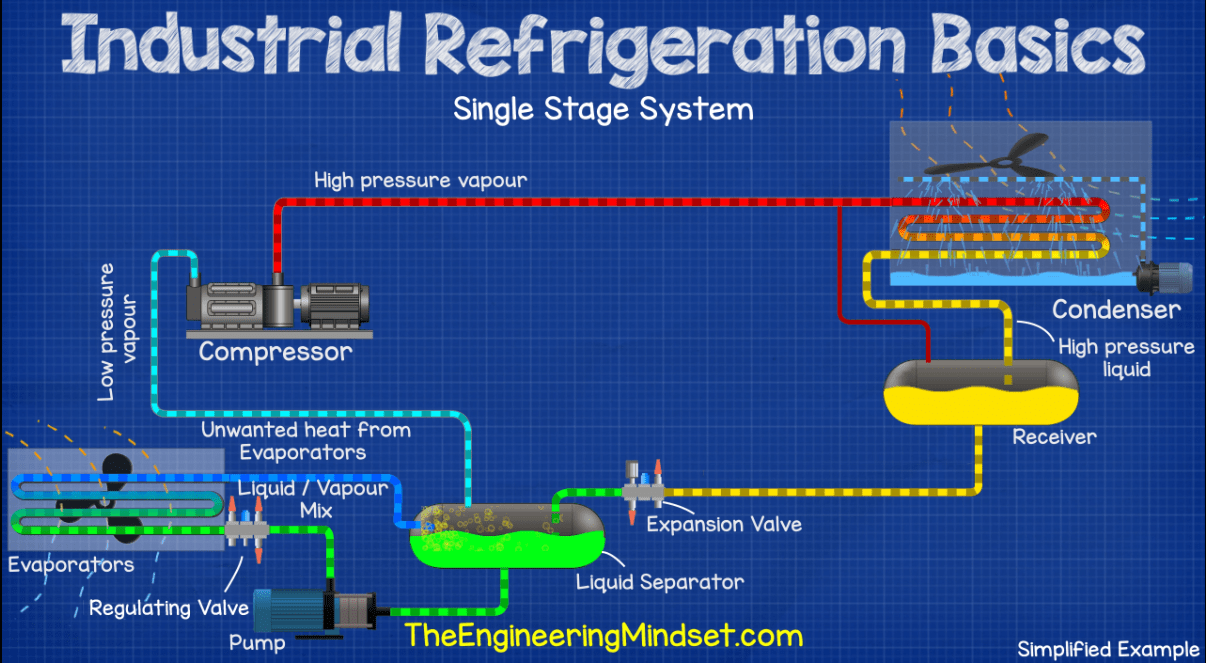
Single stage, this is the simplest ammonia industrial refrigeration system other than a direct expansion type, so we’ll start here
We start off with the compressor, this is the heart of system and is what pumps the ammonia refrigerant around the refrigeration system to provide the cooling. It pulls in refrigerant that has collected all the unwanted heat from the evaporator and it compresses this into a much smaller volume so all that thermal energy is very tightly packed together, making the refrigerant very hot.
The refrigerant is sucked into the compressor as a low-pressure vapour and it leaves as a high-pressure vapour.
The high pressure refrigerant vapour exits the compressor and flows to the condenser
The condenser cools the refrigerant down by pulling the unwanted heat out of the refrigerant and discharges heat this into the ambient outside air. This is typically done by passing the hot refrigerant through the inside of some small tubes and using a fan to force cooler ambient air across the outside of the tubes to cool it down and carry the heat away. Additionally, we’ll often find a small pump spraying water over the pipes, some of this will evaporate and help carry more heat away. The refrigerant is sealed inside the pipe and doesn’t come into contact with the air or water, it is always separated the two never meet or mix. Only the heat of the refrigerant passes through the pipe wall and is carried away by the air and water.
As the heat is removed the refrigerant condenses into a liquid. So it leaves the condenser as a high pressure liquid refrigerant and flows to the receiver.
The receiver is a storage vessel for a reservoir of liquid refrigerant and holds any excess that’s not in use. This allows it to maintain a minimum head pressure and also perform under varying cooling loads, providing a buffer. We’ll likely find a line running between the receiver and the condenser inlet, this is just to provide pressure equalisation and allows the liquid refrigerant to flow out of the condenser and into the receiver easily.
The refrigerant then flows to the expansion valve which regulates the pressure and addition of liquid refrigerant to the evaporator circuit.
From the expansion valve the refrigerant flows into the liquid separator, the liquid flows to the bottom and is then typically sucked in by a set of refrigerant pumps, these pumps ensure correct circulation rate through the evaporators as the cooling load varies. The refrigerant is then pushed to the expansion valves of the evaporators which regulate the flow of refrigerant into the cooling load.
The cold refrigerant enters the evaporator and passes on the inside of some pipes inside the evaporator and a fan blows the warm room air across the outside of these tubes. The cold refrigerant absorbs this heat so the air leaves much cooler and thus provides cooling to the space. As the warm air passes across the evaporator pipes, it causes the ammonia to boil and evaporate as a part liquid part vapour mixture. As it evaporates it carry’s the heat away. Just like when water boils in a pan, steam rises from the pan and carry’s the heat away. Again the refrigerant is sealed inside the pipe and it never comes into contact or mixes with the air, the two are always separated.
The refrigerant leaves the evaporator as a liquid/vapour mixture and heads back to the liquid separator. The refrigerant which is liquid falls down and repeats the cycle through the evaporator, and the refrigerant which is vapour, rises and is sucked back into the compressor to repeat the entire cycle again. The refrigerant enters the compressor as a low pressure vapour refrigerant.
Two stage ammonia industrial refrigeration system
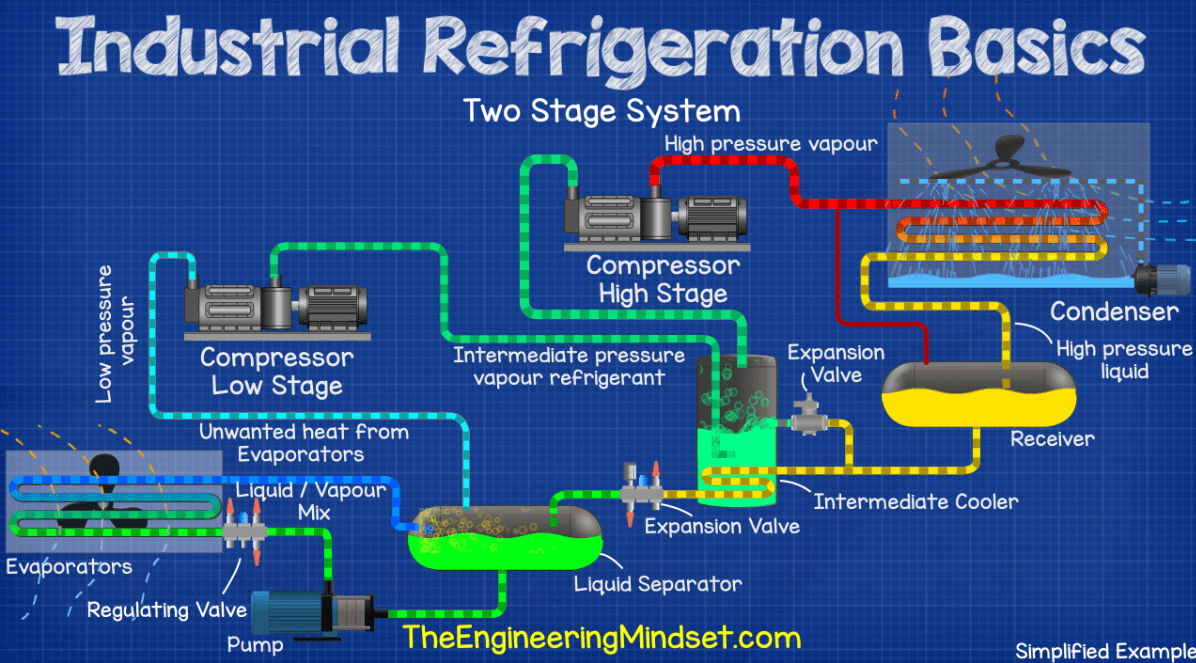
This is the next evolution of the industrial refrigeration system which is suitable for low temperature refrigeration systems, providing high efficiency and low compressor discharge temperatures.
We again have the refrigerant flowing in the same cycle but we have a few other components and cycles.
In this type we have a tank called the intermediate cooler which sits between the receiver and the expansion valve. The main flow of refrigerant passes through a coil inside the tank, the refrigerant passes through this and into the main expansion valve just like the single stage system then continues its flow via the separator, the evaporator and back to the separator. Another stream of refrigerant comes off the main line and is sprayed into the tank via an expansion valve to produce a cooling effect, as it is sprayed and evaporates in the tank it cools the submerged coil. This sub cools the main flow of refrigerant inside the coil before it flows to the main expansion valve.
The vapour refrigerant being sucked out of the separator still flows to a compressor, but this time we have two compressors, the refrigerant therefore flows to the low stage or booster compressor to increase the pressure. From here it flows and is released into the intermediate cooler which helps to condense the refrigerant.
The vapour refrigerant is sucked out of the intermediate cooler and flows to the high stage compressor where it will then flow back into the condenser to repeat the entire cycle.
Cascade ammonia industrial refrigeration system
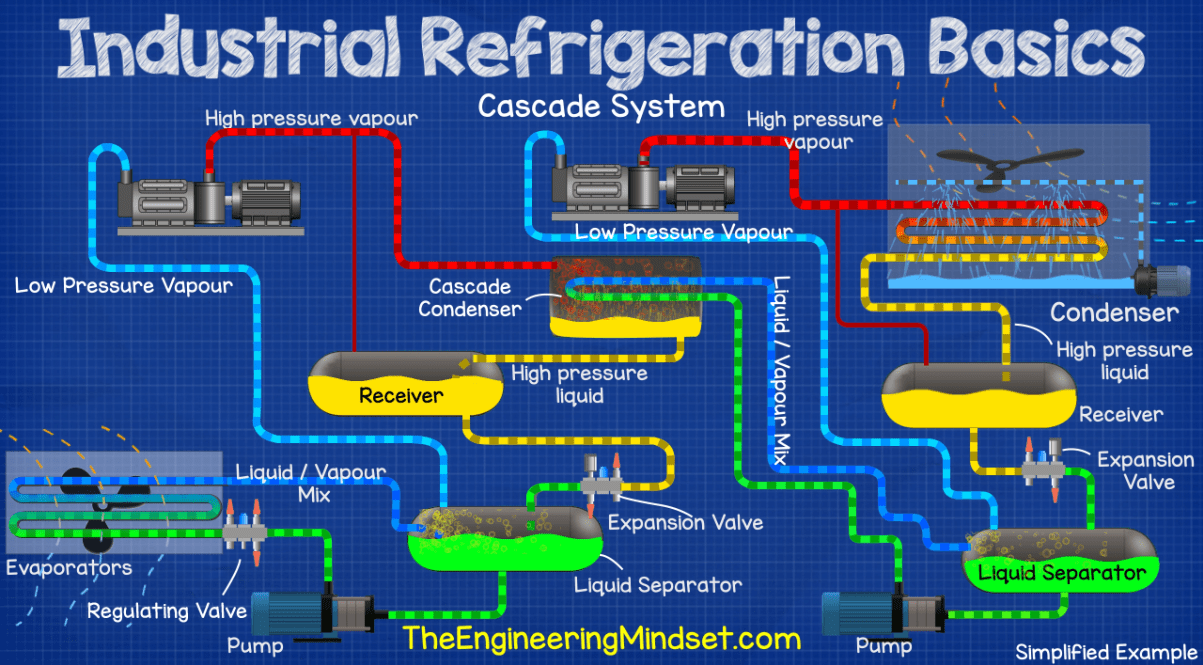
Cascade this is the most advanced one and these systems can become very complex, it’s suitable for refrigeration systems which require different temperature ranges for their cooling loads and also makes it easier and cheaper to comply with health, safety and environmental regulations.
It is a little daunting when you first look at this system, but if you’ve followed this all the way through without skipping then you should be able to follow how it works. Just give yourself a moment to trace the pipes and see where everything is flowing.
These refrigeration systems usually consist of two or more separate refrigeration circuits, often using different refrigerants to provide a cooling effect.
In this system we have two compressors except they are both circulating refrigerant around separated circuits, a high temperature circuit and a low temperature circuit. Connecting the two circuits is a heat exchanger known as a cascade condenser.
This acts as a condenser for the high temperature circuit and an evaporator for the low temperature circuit.
The two refrigerants can be the same or they can be different and optimized for each circuit. For example we could use ammonia for the high temperature side and co2 for the low temperature side.
This would mean less ammonia is used and the system would be more efficient compared to a two stage ammonia only system.

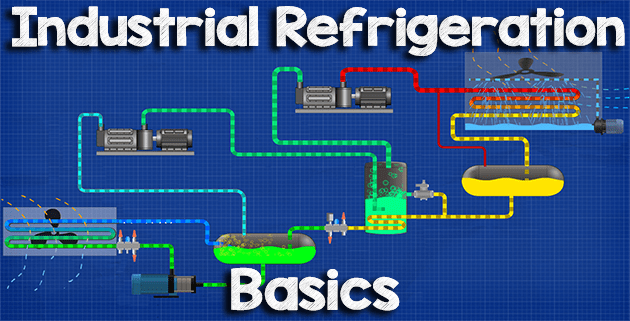
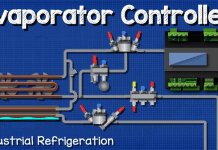

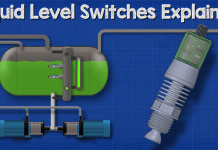
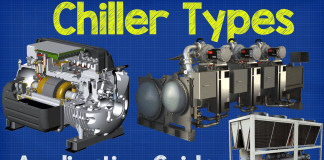

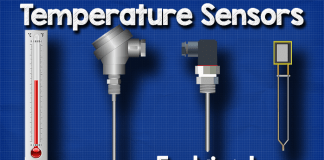


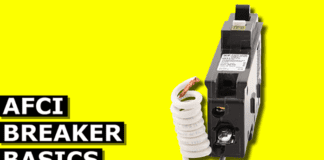








It’s interesting to know that industrial refrigerations can be found on cold food storage which we use on our delivery trucks. I was not aware that ammonia is used a refrigerant here to make sure they’re economical. We might consider getting a cascade ammonia refrigeration system for the ice cream factory if it is more efficient but we’ll see what we can afford.
Nice Blog! Thank you so much for sharing this kind of wonderful things.
Thank you, as an instructor in HVAC & R , I find your video’s great tool and use them regularly in class, your clear explanation of the how it works is great and students are better for it. Thanks again !
Really love your videos on YouTube very enlightening. What I’d like to know though is if a standard TXV will work well with ammonia as the refrigerant. Would love to know what you think about that.
Please send me install the free refrigeration item and what’s apps number
Excellent
cool
I am on the learning curve.
Not a Refrigeration Engineer.
Quality Management in its whole perspective is my field of interest.
When I look at Refrigeration, I would like to know what Constitutes Reliability in A Refrigeration System
Would like to know, where costs are likely to go out of control when initially preparing a proposal